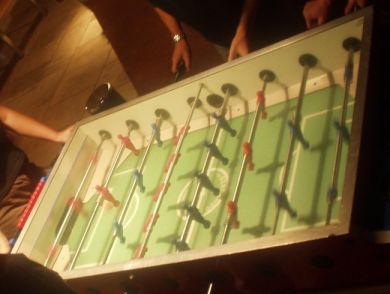Table football
|
|
Table football (known in the US as Foosball, from the German Fußball "soccer"; in German itself it's called Kicker or Tischfußball) is a table-top game based on football (soccer), and invented by Alejandro Finisterre, an editor and poet from Galicia.
| Contents [hide] |
Origins
Alejandro Finisterre was injured during one of the fascist bombings of Madrid during the Spanish civil war. Seeing many children injured like himself in the hospital (i.e. unable to play football), he thought of the idea, which was borne from the concept of table tennis. Finistere credits his friend Francisco Javier Altuna, a Basque carpenter, for making the first foosball following the directions he gave him. Although the invention was patented in 1937, Finisterre had to escape from the fascist coup d'état to France, and he lost the papers of the patent in a storm.
The Spanish for table football is futbolín.
The game
Players attempt to use figures mounted on rotating bars to kick the foosball into the opponent's goal. A foosball may travel at speeds up to 35 mph in competition. Sometimes it is hard to even see the ball at that speed, it is more of a blur. The sport/game/simulation requires quick reflexes with a delicate touch using the player's fine tuned motor skills, control and knowledge.
In table football, the basics include 'catching' the ball, or gaining control of the ball when it is moving around; passing the ball, where you have the ball in your possession with one bar, and pass it to other bars; and shooting, where you find a hole in the defense and move the ball into shooting position and shooting it.
A winner is determined in table football when one team scores a predetermined number of goals, say 5 or 10. A two goal victory is not often required. In competition every ball that enters the goal is counted, unless the player or players on the scoring team broke a rule during the play. Large events have referees that determine the infractions and penalties.
A football table can vary in size, but is typically about 4 ft long and 2 ft wide. The table usually contains 8 rows of "foos-men", which are plastic, metal or wooden figures mounted on horizontal metal bars. Each team of 1 or 2 human players controls 4 rows of figures.
The arrangement of the table footballers is standard. Looking from left to right on one side of the table, you see:
| Row 1 | Your goalie | 1 foosman (sometimes 3) |
| Row 2 | Your defense | 2 foosmen |
| Row 3 | Opponent's attack | 3 foosmen |
| Row 4 | Your midfield | 5 foosmen |
| Row 5 | Opponent's midfield | 5 foosmen |
| Row 6 | Your attack | 3 foosmen |
| Row 7 | Opponent's defense | 2 foosmen |
| Row 8 | Opponent's goalie | 1 foosman (sometimes 3) |
Table football is often played for fun in pubs, bars, workplaces, schools, and clubs with few rules. "House rules" often include a ban on spinning your foosmen, so one's hand must maintain continuous contact with the handle.
Table football is also played in official competitions organized by a number of national organizations. An international organization named ITSF (International Table Soccer Federation) was established in august 2002 to bring together all of them, as well as organizing world Championships.
A vast number of different tables exist. The table brands used on the world tour and official ITSF tournaments are "French-style" Bonzini, "American-style" Tornado, "Italian-style" Roberto-Sport, "Belgian-style" Eurosoccer. Other major brands include Kicker, Garlando, Lowen-Soccer, Warrior, Lehmacher, Leonheart and many more.
Differences in the table types have great influence on the playing styles. Most table have one goalie whose movements are restricted to the goal area. On those tables the corners are built as slopes so the ball can't get stuck out of reach. Other tables have three goalies, one in the center and one in each corner to reach the ball so sloped corners aren't needed. Another major difference is found in the balls, which can be made of cork, plastic or even marble and metal, varying the speed of shots a great deal, as well as the "grip" between the man and the ball.
Foosball strategy varies greatly. With teams of one human each, it is impossible for each person to control all four rows of foosmen simultaneously. Some players keep the left hand always on the goalie or defensemen and move the right hand among the other three rows. More aggressive players may take up an attack with the offense and midfield, leaving the goalie unattended.
With practice, it is possible to learn very fast "set-piece" moves, including the "snake", "pull-shot" and "front-pin". The pull shot is where you position the ball near the top of the oppositions goal. Then you pull your bar, which moves the ball downwards, and you aim for the hole or corner that is no longer guarded. The snake and front-pin both involve pinning the ball, or clamping the ball with your men. That way one can sway either direction.
Robots
Robots designed to play table football by roboticists at the University of Freiburg are claimed to be able to beat 85% of casual players. They use a camera from below a transparent table base to track the ball, and an electronic control system to control high torque motors to rotate and move the foosmen. Currently an expert player can beat the robot 10 games to 1. [1] (http://www.newscientist.com/news/news.jsp?id=ns99996346)
See also
External links
- ITSF homepage (http://www.table-soccer.org/)
- foosball.com, American site with rules, tricks, results (http://www.foosball.com/)
- French table-soccer federation (http://www.francebabyfoot.com/)
- German table-soccer federation (http://www.dtfb.de/)
- Danish table-soccer federation (http://www.bordfodbold.dk/)de:Tischfußball
fr:Baby-foot pt:Totó link title (http://www.example.com)link title (http://www.example.com)

